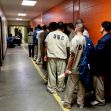Bail has been a fixture of New York's criminal justice system since before statehood. Starting in January 2020, however, bail as we know it will no longer be practiced in the majority of cases in the state of New York. Instead, most defendants accused of a crime will not be held in jail or detention pending their trial. Opponents of the move say New York will get more dangerous as yet-to-be-convicted criminals are put back on the streets. On the other hand, advocates of the change hail the measure as a huge step toward justice and ending an inequality that currently exists between those defendants who can afford bail and those who can't.
The existing and soon-to-be-extinct bail system in New York
The Constitution guarantees a defendant the right to a speedy trial, but while the charging process must be initiated swiftly after an arrest, this does not prevent a lag of several weeks or more between an arrest and an actual trial. Without bail, the defendant would be forced to spend that time in jail, despite not having been found guilty of any crime. Bail allows an individual to obtain release from jail pending trial, in exchange for putting up an amount of money as a promise to return for trial or other required court appearances. A defendant who fails to show up to court forfeits the bond and is subject to arrest and other penalties.
Often, the bail money is put up by a bail bond company rather than the defendant. The defendant purchases a bond for, say, ten percent of the bail amount, and the bond company puts its own money at risk if the defendant fails to show up. Part of the job of a criminal defense attorney is to argue for the court to set a reasonable bail amount or to release the defendant "on recognizance," meaning the defendant promises to show up to court and is not required to put up any bail money.
Arguments against bail lead to drastic changes
Bail opponents point out the injustice of the system regarding how it treats the rich and poor. Getting out on bail can be essential to keeping your job while awaiting trial and actively participating in building your defense, yet a defendant who can't afford even to buy a bond remains stuck in jail for no other reason than a financial cause. On the other hand, defendants who can afford their bail can obtain release, regardless of whether they are accused of much more serious crime than their less-wealthy peers in the system. It has been noted that almost 70% of New York's daily jail population, on average, is composed of people who have not yet had a trial or been convicted of any crime.
Starting in January 2020, judges will no longer grant bail in most cases. Instead, they will issue an appearance ticket requiring the defendant to return to court at the appointed times. This new process applies to all misdemeanors except for sex offenses and contempt charges in domestic violence cases, as well as most nonviolent felonies, including nonviolent drug felonies.
Cash bail will still be used for most violent felonies. In these cases, the courts will now be required to consider the financial circumstances of the defendant in setting the bail amount.
If the defendant is considered to be a flight risk, the judge can impose some conditions on the defendant's release, such as ordering supervised release or electronic monitoring or imposing travel restrictions on the defendant. The law requires the court to use the "least restrictive" conditions that will ensure the defendant's appearance in court.






